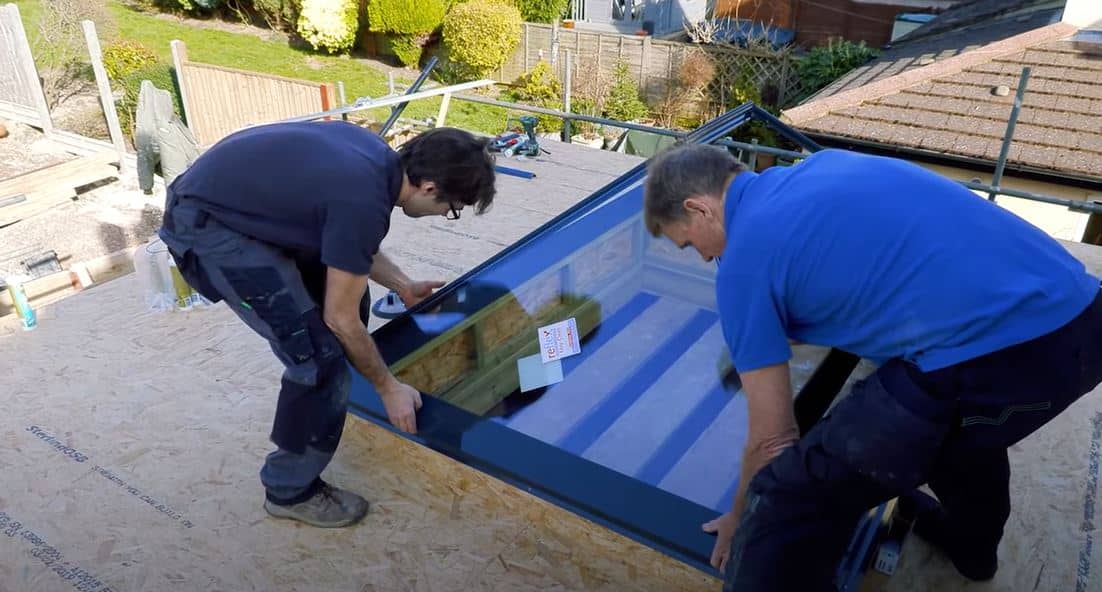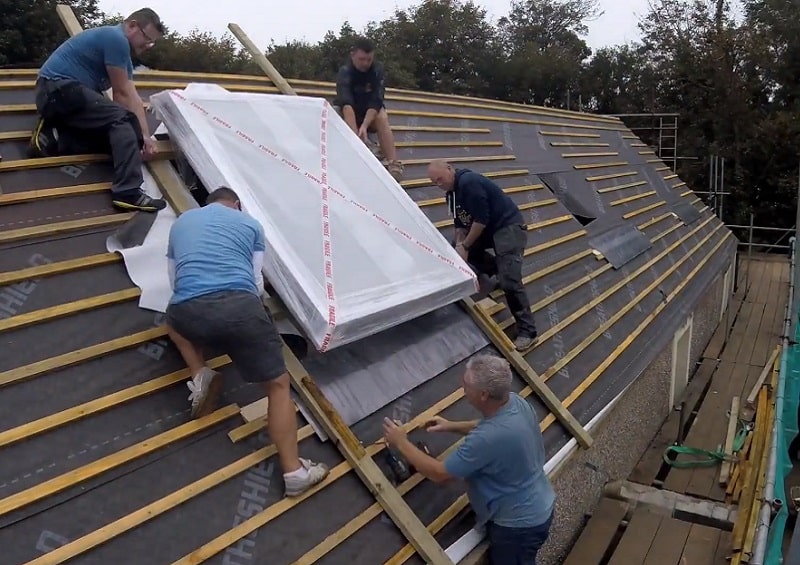How to install rooflights safely
Installing a rooflight involves moving heavy objects, using ladders and working at height, so taking the right precautions and following safety guidance is vital.
These tips, from our expert installers, will help you complete your rooflight installation safely and correctly.
1. Understand the risks before you start
With any rooflight installation, you need to work carefully, sensibly and tidily.
Understanding the risks and how accidents can happen will help you work more mindfully and safely.
There are three main risks to be aware of.
Falls from height
Falls can happen for all kinds of reasons.
For example:
- Using defective ladders or mobile platforms
- Placing ladders or mobile platforms on unstable ground
- Leaning ladders against insecure surfaces like window sills or plastic guttering
- Working on fragile roofs without taking proper precautions
- Slipping or tripping while on the roof
- Using ladders unsafely.

Electrical equipment
Using power tools on a roof creates additional risks.
Accidents can be caused by:
- Blunt or defective power tools
- Users who are inexperienced or not paying attention
- People tripping over tools or cables
- Tools falling off the roof.
Bad weather
Adverse weather creates a number of dangerous conditions for rooflight installation.
You shouldn’t attempt to install rooflights where there’s:
- Rain and surface water
- Ice and snow
- Strong winds
- Glare from low sun.

2. Make sure you have the right equipment
Having all the right equipment and components is essential for installing rooflights correctly and safely.
If you get to site and find you don’t have the items you need, you may feel pressured to improvise or use makeshift measures to get the job finished on time.
Check the manufacturer’s instructions before you set out. This will enable you to see what equipment you’ll need and make sure you have it with you.
All equipment should be well-maintained and suitable for the task, with no faults or defects.
Wear suitable clothing
You need to be suitably dressed for working at height. Wear comfortable clothes that are easy to move around in. Make sure you have non-slip footwear and eye/ear protection, if necessary.
Tie back long hair, make sure bootlaces are tied properly and avoid wearing clothes that are too baggy or have hanging cords. These can all get caught in ladders or power tool mechanisms.
Follow the manufacturer’s instructions
The safety and effectiveness of a rooflight can be compromised if you don’t assemble, handle and install it correctly. To avoid any problems, it’s important to follow the instructions provided by the rooflight manufacturer.
These instructions may vary according to the manufacturer and the product, so it’s important to read and follow them carefully on every installation. Roof Maker’s technical guides are comprehensive and our customer service team are available if you have any questions.
Determine if the roof is fragile
Some existing roofs — particularly older roofs — can be fragile.
It’s not always possible to install a new rooflight in a fragile roof, but you may be asked to replace one. For example, old wooden-framed rooflights may need replacing if they go rotten and start leaking into the property.
Roof Maker’s Luxlite LP is a lightweight, aluminium pitched rooflight that can be a suitable replacement for these older wooden-framed rooflights.
Before you start working on an existing roof, you need to know whether it’s fragile. This can only be decided by a competent person.
If you’re in any doubt, it’s safest to presume the roof is fragile and take the necessary safety precautions.

Work at height safely
Working at height can’t be avoided when you’re installing a rooflight, so you should take the necessary precautions to ensure safety at all levels.
This means your safety on the ladder and on the roof itself. And the safety of anyone on the ground below, while you’re working.
The HSE has a full guide to working safely at height.
And there are separate sections specifically on safe use of ladders and health and safety in roof work.
You should follow this guidance when undertaking any rooflight installation or maintenance.
Sweep the roof
It’s advisable to sweep the roof before you start work. This will remove any debris, like moss, twigs and leaves, that could potentially cause slips, trips and falls.
Avoid putting weight on the glass
When installing a rooflight, you should never stand on or lean on the glass.
If the glass is labelled non-fragile, it means it will provide some safety in case someone accidentally falls on it. It does not mean the glass is safe to walk on.
The only rooflight that will be safe to walk on is a purpose-built and correctly installed walk-on rooflight. These rooflights are designed for use as a walkway and will be much heavier and more costly than a conventional rooflight.
Do your customers need quality rooflights?
Roof Maker’s range includes premium rooflights for both flat and pitched roofs.
All rooflights are designed and manufactured in-house. This means they can be made to bespoke sizes and customised to your customers’ specifications.
Products are packaged and delivered by our experienced team, so you can rest assured, all the components will be provided and your rooflights will arrive in perfect condition.
For more information, visit our product pages, call our experts on or email [email protected]
